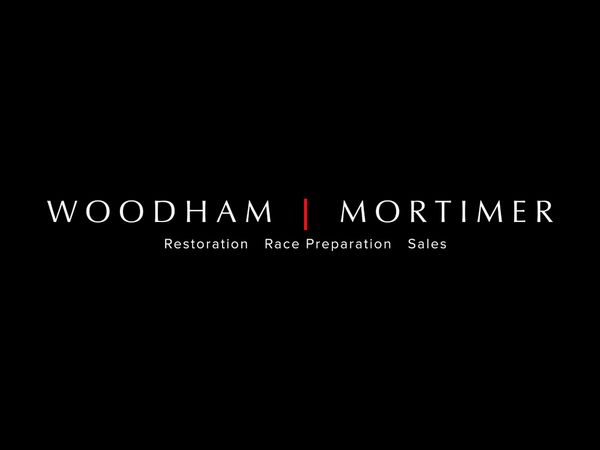Extensive Period Racing History | Pebble Beach-Award Winning Restoration
Coachwork by Zagato
Estimate: $4,300,000 - $4,600,000
Chassis: 2155
The Definitive Maserati GT of the 1950s
One-of-a-Kind Double-Bubble Coachwork Updated by Zagato in 1958
Raced Extensively in Period, Including at the Mille Miglia, Monza, and Vallelunga
Exquisite Award-Winning Restoration by Italian Marque Specialists and Paul Russell and Company
Accompanied by Manuals, Tool Kit, and Spare Set of Borrani Wire Wheels
Extensive Documentation File Includes Report by Maserati Historian Adolfo Orsi Jr., ACI Records, Factory Correspondence, and Period Photographs
The Definitive Maserati GT of the 1950s
One-of-a-Kind Double-Bubble Coachwork Updated by Zagato in 1958
Raced Extensively in Period, Including at the Mille Miglia, Monza, and Vallelunga
Exquisite Award-Winning Restoration by Italian Marque Specialists and Paul Russell and Company
Accompanied by Manuals, Tool Kit, and Spare Set of Borrani Wire Wheels
Extensive Documentation File Includes Report by Maserati Historian Adolfo Orsi Jr., ACI Records, Factory Correspondence, and Period Photographs
1,986 CC DOHC Twin-Plug Inline 6-Cylinder Engine
Three Weber 40 DCO/3 Carburetors
160 BHP at 6,000 RPM
4-Speed Manual Gearbox
4-Wheel Hydraulic Drum Brakes
Front Independent Suspension with Coil Springs and Houdaille Shock Absorbers
Rear Live Axle with Quarter-Elliptical Leaf Springs and Houdaille Shock Absorbers
PROVENANCE
Roberto Federici, Rome, Italy (acquired new in June 1956)
Gianfranco Peduzzi, Olgiate Comasco, Italy (acquired from the above in July 1956)
Carla Calzeroni, Genova, Italy (acquired in April 1958)
Maria Pallotti, Genova, Italy (acquired in July 1958)
Natale Gotelli, Italy (acquired by 1960)
Gianfranco Bonetto, Alessandria, Italy (acquired in October 1960)
Concetta Bruna Barletta, Bordighera, Italy (acquired in October 1960)
Giacomo Laurenti, San Remo, Italy (acquired by June 1961)
Gino Quinti, Italy (acquired by December 1961)
Rowita S.p.A., Milan, Italy (acquired in 1963)
Enrico Eusebio Bertotto, Vercelli, Italy (acquired in 1968)
Rino Botteon, Cimadolmo, Italy (acquired in 1993)
John F. Bookout Jr., Houston, Texas (acquired in 2000)
Current Owner (acquired from the above in 2008)
RACE HISTORY
Mille Miglia, May 1956, Luigi Fornasari, No. 311 (DNF)
Aosta-Gran San Bernardo Hillclimb, September 1957, Moioli (Noris), No. 48 (Unknown)
Pontedecimo-Giovi Hillclimb, September 1957, Moioli (Noris), No. 306 (4th in Class)
Trieste-Opicina Hillclimb, October 1957, Gotelli, No. 198 (2nd in Class)
Bologna-San Luca Hillclimb, May 1958, Moioli (Noris), No. 306 (DNF)
Bolzano-Mendola Hillclimb, July 1958, Gotelli (9th in Class)
Trento-Bondone Hillclimb, July 1958, Gotelli (6th in Class)
GT Races at Vallelunga, May 1959, Moioli (Noris), No. 128 (1st)
1st Gran Premio della Lotteria di Monza, June 1959, Bonetto, No. 44 (Unknown)
Pontedecimo-Giovi Hillclimb, September 1959, Bonetto, No. 200 (3rd in Class)
EXHIBITED
Concorso d’Eleganza Villa d’Este, Cernobbio, Italy, May 2005
Keels and Wheels Concours d’Elegance, Seabrook, Texas, May 2006
Desert Classic Concours d’Elegance, Palm Springs, California, March 2008
Pebble Beach Concours d’Elegance®, Pebble Beach, California, August 2009 (Class Award)
The Quail, A Motorsports Gathering, Carmel, California, August 2010
Classic Sports Sunday at Mar-a-Lago Club, Palm Beach, Florida, January 2013 (Class Award)
Pebble Beach Concours d’Elegance®, Pebble Beach, California, August 2014
LITERATURE
Walter Bäumer, Maserati A6G 2000 Zagato, pp. 15, 21, 49, 51, 208, 224, 232, 234, 236–245
THIS CAR
At the 1954 Paris Auto Show, Maserati introduced the A6G/54, the final evolution of its celebrated A6 road cars. A development of the magnificent A6GCS sports racer, the new two-liter Maserati featured a twin-cam straight-six engine, large finned aluminum drum brakes, and a sophisticated chassis.
Of the 60 A6G/54 examples that were built through 1957, 20 cars were clothed with stunning alloy berlinetta coachwork by Zagato. These rare lightweight Maseratis were favorites in the two-liter GT class, garnering class wins at Monza and the Mille Miglia. Individually built with unique details, the A6G/54 Zagato Berlinettas are revered for their exquisite design, competition pedigree, and acclaim as Maserati’s final dual-purpose sports car.
Chassis 2155 is notable for its period racing history and its important stylistic developments conducted by Zagato in 1958. More recently the subject of an exacting two-phase restoration, the Maserati has since been presented at some of the world’s premier automotive events.
Chassis 2155 is the 17th of 20 Berlinettas built by Zagato, and one of nine examples that originally wore what Maserati historian Walter Bäumer refers to as the third series of A6G/54 coachwork, featuring dual hood scoops, curved rear fenders, four chrome spears on the front fenders, bumperettes, and a small dashboard arrangement centered on two small primary gauges.
With factory build sheets dated May 19, 1956, chassis 2155 was completed just in time for the Mille Miglia held 10 days later. Still displaying a temporary factory registration and remaining unpainted, the A6G/54 is shown at the race in a period photo with a crowd admiring its gorgeous bare aluminum coachwork. Owned by the factory at the time, the car was loaned for the Mille Miglia to Luigi Fornasari of Verona, Italy, who then also owned chassis 2150, the immediate predecessor to 2155 in the Zagato build sequence.
Fornasari used 2150 more regularly in competition than 2155, but these two chassis were somewhat interchangeably raced and registered during this time. Since 2155 was built with Zagato’s trademark double-bubble roof, period photos are immensely helpful in distinguishing this car’s activity from 2150, which had the typical smooth roof contour. Its rich history has also been documented by the research of marque historian Adolfo Orsi Jr., independent Maserati researcher Walter Bäumer, as well as original build sheets and ACI registrations.
At the 1956 Mille Miglia, Fornasari went off the road, suffering an accident in 2155 near Ravenna and retired early from the race. Returned to Zagato for coachwork repairs, 2155 was completed with body alterations, including a smaller radiator opening and a lower fender line around the headlamps, and was finished in silver paint. Thin strips of alloy trim were added to its beltline, and 2155 is the only A6G Zagato Berlinetta to receive such a treatment. A period photo depicts the re-trimmed car parked in Fornasari’s driveway with his young son standing in the foreground.
In June 1956, the A6G/54 was sold to the first owner of record, Roberto Federici of Rome. He retained possession for only a brief time before selling the car to racing driver Gianfranco Peduzzi of Olgiate Comasco in July. In September 1957, the Zagato was driven in the Aosta-Gran San Bernardo Hillclimb by Giacomo Moioli, a dealer from Verona who raced under the name Noris. He also finished 4th in Class at the Pontedecimo-Giovi Hillclimb later that month.
In October 1957, the Maserati was raced at the Trieste-Opicina Hillclimb by Natale Gotelli, who later acquired the car, and in May the car was raced again by Noris at the Bologna-San Luca Hillclimb, where an accident forced an early retirement and another return to Zagato for repairs.
While at Zagato in 1958, an accident while testing would lead to the creation of the stunning design the car wears today. It began when Gianni Zagato, the racing driver and younger brother of Elio Zagato, was tasked with test-driving 2155, and his exuberance got the better of him. Excessive speed led to a major off-road accident that destroyed some sections of the coachwork. While unfortunate, this accident provided Zagato an opportunity to create a design study for the marque’s recent touring model, the 3500 GT, in what would be the carrozzeria’s final exercise on a Maserati chassis.
The new design, realized during June 1958, embodied conceptual renderings first shown on a 3500 GT model brochure circulated during early 1957. The heavily revised body featured a lower and straighter front-fender line, a notchback roof, and sharper rear fins that extended from straightened haunches. Gianfranco Bonetto, a successful gentleman driver from Alessandria, used 2155 with the new coachwork in the Gran Premio della Lotteria in June 1959. He campaigned the car again three months later at the Pontedecimo-Giovi Hillclimb, finishing 3rd in Class.
In October 1960, Bonetto bought the A6G/54, and the Zagato underwent maintenance and repairs at the Officina Autosport, a garage in San Remo. The Maserati was not raced any further in period, and by August 1963 it was registered to the corporation Rowita, S.p.A., in Milan. Five years later the car was purchased by Enrico Eusebio Bertotto, who is believed to have retained possession through 1993. During his ownership, the car was restored with a Kamm tail, covered headlamps, and finished in red with painted wire wheels. The car was acquired in January 1993 by Rino Botteon of Cimadolmo.
In December 2000, John Bookout Jr., one of the preeminent collectors of coachbuilt Maseratis, acquired 2155. Mr. Bookout commissioned leading Italian marque specialists to restore the car under the supervision of marque authority Adolfo Orsi Jr. During this process, the A6G/54 was returned to its period splendor, looking as it did when it left Carrozzeria Zagato in 1958. Following restoration, the beautiful Maserati Berlinetta was presented at the 2005 Concorso d’Eleganza Villa d’Este and several concours in the US.
In late 2008, Mr. Bookout sold the Maserati to the consignor, a collector based in Texas. Seeking to sharpen the car’s presentation both mechanically and cosmetically, he entrusted it to the world-renowned specialists at Paul Russell and Company. Documented by over 150 pages of invoices, the brakes, clutch, carburetors, ignition, water pump, and many other items were rebuilt. The talented craftsmen at Paul Russell and Company were fastidious in their efforts to perfect the Zagato and attended to many cosmetic details, including the finishes on the chassis and coachwork.
The car debuted to stunning effect at the Pebble Beach Concours d’Elegance® in August 2009, where 2155 was bestowed with a class award. The Maserati was then shown at the 2010 Quail, A Motorsports Gathering in Carmel, California, and at the 2013 Classic Sports Sunday at Mar-a-Lago Club (where it won another class award). In August 2014, the Berlinetta returned to Pebble Beach for Maserati’s centennial celebration.
This extraordinary and important A6G/54 is documented with factory build sheets and internal memos, ACI registrations, and a report prepared by marque historian Adolfo Orsi Jr. The car is also accompanied by a spare set of Borrani wire wheels, a tool kit, original owner’s manuals, and a body buck used during the Italian restoration. With its remarkable one-off Zagato coachwork, this beautiful Maserati is particularly collectible for its unique history, which has been exceptionally researched. It would make an outstanding addition to any level of collection, ideal for presentation at prestigious concours d’elegance and Maserati events.




























